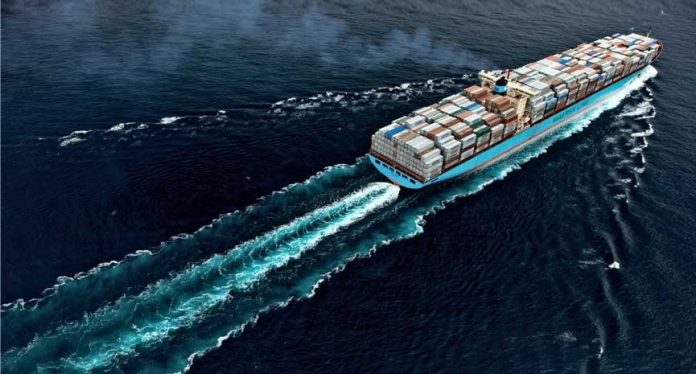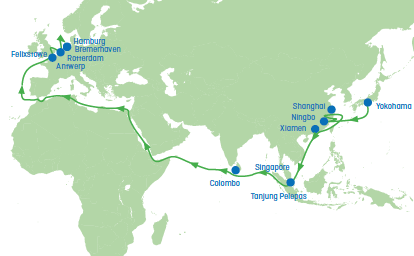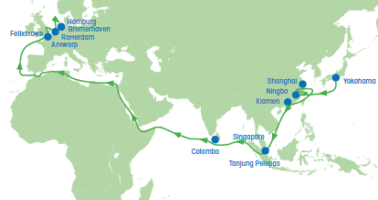The new Clydebank Declaration, presented on Wednesday at the UN COP26 meeting in Glasgow, backed by the United States, the United Kingdom, Japan, Norway and 15 other countries, aims to have at least six "green maritime corridors in place. "by" the middle of this decade "and develop" more and greater "routes by 2030.
"We will evaluate these objectives by the middle of this decade, with a view to increasing the number of green corridors," the signatories point out in their declaration of intent.

With increasing pressure on shipping to decarbonise by 2050, this initiative is expected to spur growth and investment in the infrastructure and technology needed for zero emissions.
The Danish Transport Minister stated that he wanted to see at least 200 ships using primarily zero-emission fuels operating on the high seas shipping lanes by 2030.
"Green corridors could be the tipping point for developing the green maritime solutions we need to meet our shipping emissions targets as well as our collective climate goals"
Benny engelbrecht, Minister of Transport of Denmark,
Lloyd's Register chief executive Nick Brown said green corridors were essential to support the viability of the early drivers of shipping decarbonisation.
"Highlighting major port hubs and specific trade routes allows for a full understanding of where early investments in onshore infrastructure for the production of new fuels could have the greatest initial impact."
Nick brown CEO of Lloyd's Register,
Partner countries are committed to enabling partnerships with and between maritime sector stakeholders, such as shipping companies and ports, as well as reducing potential obstacles to their development. See the interventions in the COP26 panel:
The Next Wave Report: Green Corridors
The statement thus supports the Getting to Zero coalition report, The Next Wave: Green Corridors , an intersectoral group of companies and organizations, has concluded that countries can take advantage of existing favorable conditions, such as an established export position, to develop these green corridors through specific regulations and financial incentives.
In 2020, the Getting to Zero Coalition - a partnership between the World Maritime Forum, Friends of Ocean Action, and the World Economic Forum - and the Energy Transition Commission outlined the business case for a commercial-scale zero-emissions pilot in The First Wave: A Blueprint for Zero- Emission Shipping. In 2021, it is already clear that ambitions need to be raised to more than just pilots
The new study, The Next Wave: Green Corridors , examines how green corridors - specific trade routes between major port hubs where zero-emission solutions are demonstrated and supported - can be conceived, prioritized and designed to accelerate the speed of the shipping transition
"Green corridors can help simplify the challenges of zero-emission shipping, bringing solutions to the water faster and at significant scale. The maritime ecosystem is embarking on a journey towards a transformed, zero-emission maritime sector. The task "What we have ahead of us is complex, but not impossible."
Johannah Christensen, Managing Director of the World Maritime Forum.
The study shows that green corridors can create favorable conditions to accelerate industry action and enable policy makers to create an enabling ecosystem with specific regulatory measures, financial incentives and safety standards. In these contexts, the mutually reinforcing actions that are needed by industry and policy makers to decarbonize shipping become easier, creating end-to-end solutions that can be replicated globally.
"Green corridors will allow us to move from ambition to action. However, there will continue to be a cost gap between fossil-based shipping and zero-emission shipping of the order of 25% to 65%. Specific government action to close "This cost gap in the corridors could bring great benefits for the transition in general"
Faustine Delasalle, Co-CEO of the Mission Possible Partnership.
The Next Wave draws its conclusions based on studies of three runners different, after consulting with more than 30 companies throughout the value chain, including many that are active on the routes in question. Each of the corridors represents a different type of opportunity for transition:

1. Australia-Japan iron ore corridor


"For zero-emission shipping to be successful, it must be an economically competitive option for companies like Star Bulk. Green corridors are trade routes where policy support and industry collaboration could ensure first-mover benefits. reach compensate for the costs and risks they are assuming"
Charis Plakantonaki, Chief Strategy Officer, Star Bulk Carriers Corp
In all green corridors, the success factors are probably similar:
- Consensus at the corridor level on the fuel pathways
- Political support to help closing the fuel cost gap higher cost zero emissions
- Value chain initiatives to group demand.
Aligning with a corridor-specific decarbonization roadmap, based on these factors, could provide all stakeholders with the confidence to invest, coordinate, and deliver the scale solutions needed by 2030.
The Next Wave: Green Corridors report was initiated by the Getting to Zero Coalition's Motivating First Movers workstream. The World Maritime Forum and Mission Possible Partnership, with analysis by the Energy Transitions Commission and McKinsey & Company, have collaborated in the preparation of this final report.

